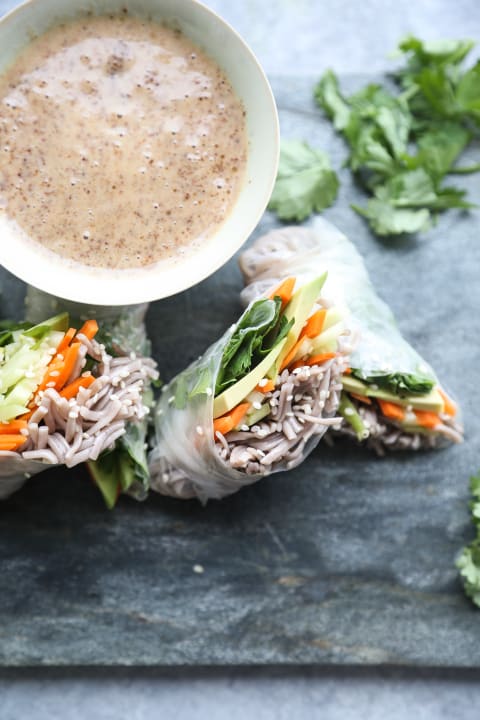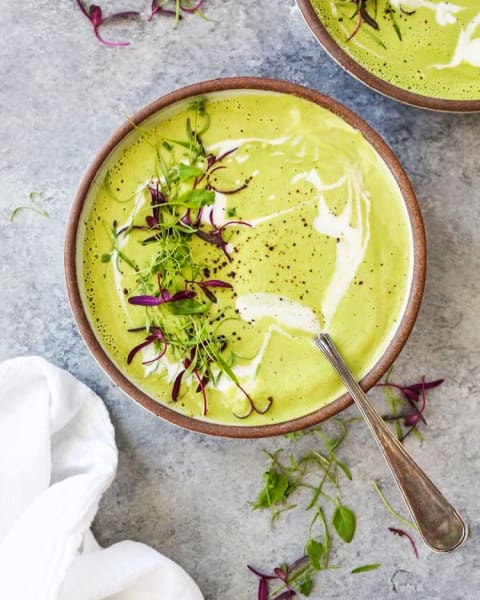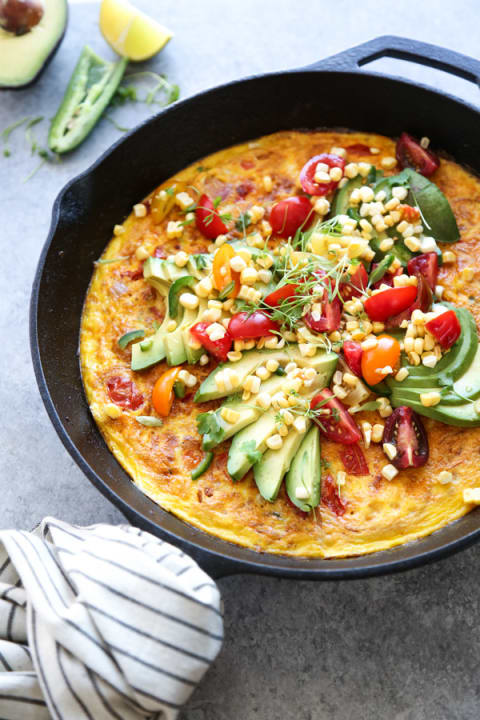Advertisement
Every Question You Ever Had About Going Gluten-Free — Answered


When I first realized that I had a serious gluten sensitivity, all I felt was dread.
This was seven years ago, back in the day when the only bread replacement was a sad-looking loaf in the dark corner of the freezer aisle, and the rice pasta fell apart and/or congealed into one giant noodle on your plate.
It was also shortly after I left my corporate job to pursue a fledgling career as a chef and food writer. To say that the change was jarring to both my professional and personal life is an understatement. I got the recommendation at a holistic doctor’s appointment two weeks before I was setting out to promote my first cookbook. It contained 100 recipes, 50 of which I could no longer eat.
After I moved through the seven stages of grief, though, I could see what simply making this one change to my diet could do for my overall health. My digestive issues lessened, my skin looked like it had just been covered with a generous Instagram filter, and I was finally waking up with energy, excited to take on the world.
But it wasn’t until the next stage of my health journey, when I took on a year’s worth of additional lifestyle experiments, that I came to understand exactly what gluten was doing to my body, and how completely removing it could help me manage my autoimmune disease, Hashimoto’s thyroiditis.
I’ve oscillated from an open relationship with gluten—occasionally getting frisky with a pie of thin-crust pizza—to a strict, celiac-style breakup and have learned so much in the kitchen and about myself in the process.
Now that I’ve made cooking gluten-free a central part of my work as a culinary instructor and chef, I wanted to share all the information and resources I wished I’d had when I first took the plunge. It’s certainly a very different landscape for dietary restrictions than it was seven years ago. But that’s not to say that going gluten-free is without its challenges. Read on for tons of recipes and advice that will make your transition as joyous and delicious as possible.
What is gluten?
Despite 20 million Americans reportedly eating gluten-free on a regular basis, when Jimmy Kimmel stopped unsuspecting pedestrians on the street to ask a simple question—what is gluten?—very few had a clue.
So let’s spell it out, shall we?
Gluten is a type of protein that’s found in many grains, primarily wheat by-products and varietals like wheat berries, semolina, spelt, farro, kamut, einkorn, and durum. Other grains that contain gluten include rye and barley.
The protein itself acts as a binder. As a bread or pasta dough is worked, the gluten content develops, acting as the glue for baked goods and giving them that spongy elasticity.
Why would someone want to go gluten-free?
The primary group of people that needs to remove gluten from their diets are those who have been diagnosed with celiac disease.
For celiac suffers, a bite of gluten causes antibodies to attack the villi of the small intestines. Even the smallest cross-contamination—a few breadcrumbs from an artisanal grilled cheese on the deli counter—can set off a reaction. The result of these self-attacks can lead to long-term intestinal damage and the development of other autoimmune conditions.
Celiac disease can be difficult to diagnose as it affects people differently, and not everyone has an immediate reaction. This is known as "silent" celiac disease. Besides digestive symptoms, other common signs are fatigue, weight loss or nutrient deficiencies, depression or anxiety, and bone or joint pain.
The far more mysterious population of gluten avoiders are those with "non-celiac gluten sensitivity."
The best way to determine if you fall into that camp is to simply remove gluten from your diet for 21 days (either through a modified or full elimination diet) and then reintroduce it in a targeted way to gauge your reaction.
Why is gluten making some people sick?
There’s been a lot of chatter in the media about non-celiac gluten sensitivity and why it’s exploded in the last five years.
Contrary to what many believe, GMO white flour has not been approved for sale anywhere in the world. But wheat has been hybridized over the years to withstand increased levels of pesticides, which some experts believe is the cause of many people’s inflammatory response, not the wheat itself.
Bread is also made very differently than it was a century ago, with the starkest change being the rise time. A higher percentage of gluten allows factories to develop the elasticity in bread much faster—from 24 hours to a mere 20 minutes—through a creepy stabilizing ingredient called vital wheat gluten, which is now added to many processed baked goods.
Some people with a gluten sensitivity find that they have an easier time digesting bread that’s made with traditional techniques and higher-quality, less-processed wheat. Before swearing off gluten for good, see how you react to a fresh loaf sold at the farmers market. If you’re traveling abroad in Europe, eat an authentic baguette or boule baked from a local artisan the same morning. And if you don’t have access to either of those options, simply source a good-quality flour and try making bread yourself! For the overachievers, you can even purchase whole grain wheat and a grinder to produce your own flour.
Another argument is that the rise in gluten sensitivity mimics the rise of autoimmune disease in general. It’s estimated that over 50 million Americans suffer from autoimmunity, which includes conditions like lupus, multiple sclerosis, type 1 diabetes, Hashimoto’s thyroiditis, and rheumatoid arthritis.
For people like myself, whose immune systems have already gone off the rails, gluten may pose an issue for cross-reactivity and produce more unwanted symptoms of inflammation.
For example, thyroid protein and gluten protein look fairly similar. So for those who suffer from autoimmune thyroid diseases like Hashimoto’s and Graves' disease, gluten could be both a trigger for an autoimmune response and a way to control the worse effects of your disease through its omission.
What grains are gluten-free?

Though many think that GF living means no carbs for life, there are actually quite a few grains and grainlike seeds that fall into the category of gluten-free.
Some of the most popular gluten-free options are rice, corn, quinoa, millet, amaranth, buckwheat (contrary to the name), sorghum, teff, and oats, so long as they are processed in a certified gluten-free facility.
What are the challenges of being gluten-free?
The landscape for gluten-free eating is very different than it was seven years ago when I first parted ways with wheat. Today, mainstream grocery stores have entire gluten-free sections with plenty of brands to choose from. There’s also an official gluten-free certification that those with celiac can use to determine whether a product has been produced in a facility that is 100 percent gluten-free.
The trickiest part about crafting your gluten-free pantry is not falling prey to junk foods that may be just as irritating to your system. Gluten-free does not a healthy food make. All you have to do is read the ingredient labels of gluten-free bread to know how many different ingredients go into replacing the elasticity of gluten. Some of these refined flours can also cause a cross-reactivity for autoimmune sufferers and be equally inflammatory to your system, especially GMO corn. Moreover, with so many ingredients in gluten-free products, it can be hard to tell what you’re really reacting to.
What is gluten cross-reactivity?
If you are sensitive to gluten, it may be worth exploring some other ingredients that are known for their cross-reactivity. Once your immune system has deemed gluten a harmful invader, your body creates antibodies to target it and alert the troops. The problem is that these whistleblowers are not always adept at distinguishing gluten from other similarly structured molecules.
The proteins in dairy—casein and whey—can cause an issue of mistaken identity, as they look similar to the gluten protein. The same often happens with oats, millet, rice, and corn.
If you’re not feeling better from removing gluten alone, it might be worth doing an elimination diet with these additional grains, as they tend to be on the ingredient lists of many gluten-free products.
What about alcohol?
The biggest category of alcohol to avoid while on a gluten-free diet is beer, which uses barley, rye, and sometimes wheat in the brewing process. There are many craft beer options that use hops (which are gluten-free) combined with other gluten-free grains as their mash (here is a list). Hard cider is a great option for those looking for the same fizz and low alcohol content in a can or bottle.
Whiskey is also made from rye, wheat, or barley, but there is some debate as to whether the distillation process sufficiently removes gluten from the final product. It’s best to err on the side of caution for alcohol brands that are not explicitly labeled as gluten-free (here is a list), as those who are very sensitive may react.
Bourbons made entirely from corn, vodkas that are potato based, and malt-free rum are viable options. But, again, every brand differs in their mash and processes, so choose your bottles wisely.
How do you cook on a gluten-free diet?

Once you have a few go-to swaps in your back pocket (like those outlined below), gluten-free cooking at home is a breeze. Béchamel and stews can be thickened from AP gluten-free flour blends, brown rice, or coconut flour. Breading protein, topping casseroles or binding meatballs and veggie burgers, can be done with ground gluten-free oats, crushed non-GMO tortilla chips, brown rice or corn cereal, pulsed stale gluten-free bread, or store-bought gluten-free panko. You can buy great gluten-free pastas and use them as a base for your gluten-free meal.
Things get slightly more complicated when you begin dipping your toes into baking territory. The biggest thing to note is that gluten-free flours vary in density and cannot be substituted cup for cup with regular AP flour. To figure out a proper substitution, purchase a kitchen scale and match the weight. Some brands (Bob’s Red Mill, Cup4Cup) have made it easier by formulating high-performing blends that mimic the density of regular flour and can be used seamlessly. If you don’t want to invest in a shelf full of gluten-free starches and flours, this is by far the easier option. For those looking to do a lot of baking at a fraction of the price, plenty of recipes exist to make your own! There are also a number of great, gluten-free desserts you can make or buy—here's a full list of the best options.
The best gluten-free recipes:
- Gluten-Free, Grain-Free Tortillas
- Gluten-Free Breakfast Cookies
- Grain-Free Cinnamon Raisin Bagels
- Gluten-Free Turmeric Breakfast Bowl
- Gluten-Free Vegan Mac and Cheese
- Gluten-Free Chocolate Peanut Butter Bites
- Gluten-Free Blueberry Muffins
- Gluten-Free Pizza Crust
- Gluten-Free Thanksgiving Stuffing
- Gluten-Free Mint-Chocolate Chip Fat Balls
- Gluten-Free Bread
- Gluten-Free Cinnamon Rolls
- Gluten-Free Pumpkin Pie
- Gluten-Free Potato Parsnip Kugel
- Gluten-Free Buckwheat Pancakes
- Gluten-Free Deep Dish Chocolate Chip Cookie
- Gluten-Free Key Lime Pie
What are common hidden sources of gluten?
Eating out, however, can pose an even bigger burden. Gluten can be a tricky item to spot on menus since it comes in so many forms and is used in a variety of different culinary techniques.
Big hidden sources of gluten are soy sauce, Worcestershire sauce, store-bought creamy condiments and dressings (sadly, not every restaurant makes theirs in house), beer, béchamel sauces used to thicken soups and stews, deli meats, imitation crab, licorice, sour candies, and chewing gum.
Red-flag words and dishes include:
- Chowders and bisques
- Stews
- Chili
- Breaded and fried anything
- Fresh tortilla chips (cross-contamination in fryer)
- French fries (cross-contamination in fryer)
- Mole sauce
- Soy glaze
- Ponzu
- Miso
- Dashi
- Gochujang
- Sushi rice
- Za’atar
- Romesco sauce (often includes stale bread)
- Creamy gazpacho
- Pappa al Pomodoro
- "Crispy" shallots and onions
- Pan-fried fish
- Hash browns
- Barbecue sauce
- Béchamel
- Rue
It’s also worth noting that many vitamins, cosmetics, and makeup products use vital wheat gluten as a filler. Make sure to read ingredient labels and purchase GF-certified products if you have a serious allergy.
Another challenge for those with celiac or serious gluten sensitivity is preventing cross-contamination. Certainly, asking about whether there’s a dedicated gluten-free fryer or when the last time the oil was changed is top of the list for anything fried. But other problem areas include counters, griddles, pasta pots, and toasters.
Even if an establishment offers gluten-free bread or pasta as an option (and many now do), you need to make sure that the kitchen knows to use a separate clean pan for toasting and an individual pot of water for cooking your pasta. Also ask the servers to make sure the prep area has been thoroughly cleaned before making your dish.
The best and worst cuisines for eating gluten-free.

Certain ingredients (like soy sauce) make eating out at various ethnic restaurants a challenge. They include:
- Chinese (soy in everything)
- Japanese (ditto)
- Korean (a little easier to get around, but watch out for condiments like gochujang and kimchi)
- French (so many béchamel bases and flour dustings)
- English/Irish (same as above)
- Italian (many offer gluten-free pasta options now, but beware of cross-contamination)
- Southern (BBQ sauce, casseroles, and fried things are not your friends)
- Creole/Cajun (roux is the base of many dishes like gumbo)
- Mexican (if you avoid fried tortilla chips, flour tortillas, and mole sauce, there are some good options)
- Spanish (watch out for stale bread in sauces. Otherwise, plenty of options)
The best include:
- Mediterranean
- Middle Eastern
- Moroccan
- Greek
- New American
- Brazilian
- Indian
- South American
- Thai (unlike Chinese food, Thai uses very little soy sauce)
- Vietnamese (same as above)
The best product swaps for gluten-filled foods.
- San-J Organic Tamari for soy sauce
- Bob’s Red Mill AP Baking Flour for white flour
- Primal Kitchen Avocado Oil Ranch for commercial ranch
- Canyon Bakehouse 7-Grain Bread for white bread
- Andean Dream Quinoa Spaghetti for regular pasta
- Mary’s Gone Crackers for water crackers
Not sure if you're gluten intolerant? Here are 10 signs to look for.